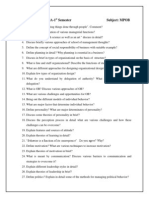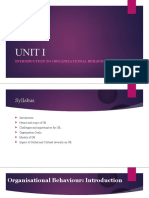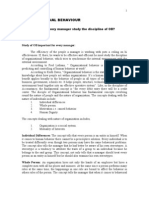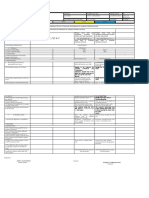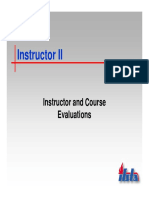Fundamentals of Management Lecture Notes
Uploaded by
Shaketia hallFundamentals of Management Lecture Notes
Uploaded by
Shaketia hallUniversity of Technology, Jamaica
Introduction to Management/Principles of Management
Module Code MAN1006/MAN1001
Lecture #1
The Fundamentals of Management and the Organization
Source: Daft, R. & Marcic D. (2011). Management: The new workplace. 7th ed. Thomson
South-
Western, Cenage Learning. Chp.1.
THE FUNDAMENTALS OF MANAGEMENT
Unit Objectives
At the end of this unit, the student will be able to:
1. Define Management and the Organization.
2. Differentiate the Functions of Management and the type of management activity associated
with each.
3. Contrast Efficiency and Effectiveness and state their importance to organizational
performance.
4. Describe the management levels and their Horizontal and Vertical Differences.
5. Compare conceptual, human, and technical skills and their relevance to managers and
employees.
6. Differentiate the various roles under the categories of Informational, Decisional and
Interpersonal, that managers perform in organizations.
What Is Management?
Early 20th century management scholar Mary Parker Follett, defined management as “the art
of getting things done through people”. Noted management theorist Peter Drucker stated that
the job of managers is to give direction to their organizations, provide leadership, and decide
how to use organizational resources to accomplish goals.
What Do Managers Do?
Get things done through people and other resources and provide leadership and direction.
Management Defined
Management is defined as the attainment of organizational goals in an effective and efficient
manner through planning, organizing, leading and controlling organizational resources.
(Daft&Marcic, 2011)
Management refers to the process of getting things done, effectively and efficiently, through and
with other people. The term process represents the primary activities that supervisors perform.
Prepared by: Flo Angus 1
Who Are Managers?
• Managers are the executive function of the organization, responsible for building and
coordinating an entire system rather than performing specific tasks.
• Managers solve problems, turn organizations around, and achieve astonishing performances.
The Functions of Management
• Planning
• Organizing
• Leading
• Controlling
PLANNING
Defining goals for future organizational performance and deciding on the tasks and resources
needed to attain them
ORGANIZING
Includes arranging and grouping jobs, allocating resources, and assigning work so that activities
can be accomplished as planned.
LEADING
Involves the use of influence to motivate employees to achieve the organization’s goals.
CONTROLLING
Monitoring employees’ activities, keeping the organization on track toward its goals, and making
corrections as needed.
The Organization
An organization is a systematic grouping of people brought together to accomplish some specific
purpose. Examples of organizations include: schools, colleges, universities, banks, libraries,
government agencies, churches, supermarkets, etc.
Organization Defined
An organization is a social entity that is goal-directed and deliberately structured. (Daft&Marcic,
2011)
Common Characteristics of Organizations
All organizations, regardless of their size or focus, have three common characteristics:
1) A Purpose
2) Composed of People
3) A Systematic Structure
Prepared by: Flo Angus 2
Organizational Performance
Performance may be measure by the degrees of EFFICIENCY and/or EFFECTIVENESS
achieved.
Efficiency
Efficiency is the amount of resources used to achieve an organizational goal. Resources include
raw materials, money and people - to produce a desired volume of output.
Efficiency refers to the relationship between inputs and outputs, calculated as the amount of
resources used to produce a product or service.
If you get more output for a given input, you have increased efficiency.
Effectiveness
Effectiveness is the degree to which the organization achieves a stated goal. In an organization,
this translates into goal attainment. It is the degree to which the organization achieves a stated
goal.
Difference Between Efficiency & Effectiveness
Whilst Effectiveness means doing the right task, Efficiency means doing things right.
Levels in The Organization
Levels in the organization may be viewed Vertically or Horizontally.
Organizational Levels - Vertical
Vertically, there are four distinct levels in an organization. The top three are management and
the lowest is non-management. At the Vertical Level, there are three (3) managerial Levels:
Top Managers, Middle Managers and First-Line Managers
Top Managers: A top manager falls at the top of the organization and is responsible for the
entire organization. (Daft, 2005). They determine the form of an organization and define its
overall character, mission and direction. (Bedeian, 1993)
Middle Managers: A middle manager occupies roles positioned above first-line and below top
management in the organizational hierarchy and is responsible for major departments. Positions
include: Department Head, Division Head, Operations Manager.
First-Line /Front Line Managers: A First-line manager is one who falls below middle
management. They are directly responsible for managing operating (non-managerial employees)
and resources. (Bedeian, 1993).
Prepared by: Flo Angus 3
Non-Managerial Employees: The base level comprises of Operative Employees – employees
who physically produce goods and services by working on specific tasks. Examples include:
clerks, machine operators, administrative assistants, sales representatives, etc.
Organizational Levels - Horizontal
Horizontally, management is viewed at a single level of the hierarchy, where management jobs
occur across, rather than from top to bottom. Here, the different types of managers would be
viewed one level at a time, for example, at the top level, CEOs, Managing Directors or
Presidents. At the middle level, Functional managers, e.g. Marketing Manager, Accounts
Manager, Human Resource Manager. At the front or first line level, Supervisors ( in the
various departments). Also included would be Divisions. For example, a company may have
several branches, or be organized by Product /Service or Geographic region.
Horizontal Management Levels
Functional Manager – responsible for a department that performs a single functional task and
has employees with similar training and skills. The functional departments include: Marketing,
Sales, Finance, Human Resources, Production/Manufacturing Accounting and Information
Technology.
General Manager (GM) – responsible for several departments that perform different functions.
The GM is responsible for a self-contained division, such as a retail store, and for all of the
functional departments within it.
Project Managers also have GM responsibility, since they coordinate people across several
departments to accomplish a specific project.
Management Skills
Conceptual Skills – the cognitive ability to see the organization as a whole and the relationships
among. (Daft, 2005).
Human Skills – the ability to work with and through other people and to work effectively as a
group member. (Daft, 2005).
Technical Skills – the understanding of and proficiency in the performance of specific tasks.
(Daft, 2005). Technical skills however, become less important than human and conceptual skills
as managers move up the hierarchy.
Mintzberg’s Ten Roles Of Management
Mintzberg’s observations and subsequent research indicate that diverse manager activities can be
organized into ten Roles.
Definition: A Role is a set of expectations for one’s behaviour.
The Categories of Roles
Prepared by: Flo Angus 4
Each role represents activities that managers undertake to ultimately accomplish the functions of
planning, organizing, leading and controlling. The roles of management are divided into three
categories:
– Informational (managing the collection and dissemination of information)
Monitor, Disseminator and Spokesperson
– Interpersonal (managing through people; motivation and leadership)
Figurehead, Leader and Liaison
– Decisional (managing through action)
Entrepreneur, Disturbance Handler, Resource Allocator and Negotiator
END OF NOTES
Prepared by: Flo Angus 5
You might also like
- Quiz 1 Principles of Management (Bpmn1013) Group GNo ratings yetQuiz 1 Principles of Management (Bpmn1013) Group G6 pages
- Principles of Management - Lecture Notes, Study Material and Important Questions, Answers67% (3)Principles of Management - Lecture Notes, Study Material and Important Questions, Answers24 pages
- Leadership and Change Management Handout All Chapter100% (1)Leadership and Change Management Handout All Chapter54 pages
- Fom Important Questions For Preparation PDF50% (2)Fom Important Questions For Preparation PDF58 pages
- Ethical Issues in Finance: - Theresa Santhosh100% (1)Ethical Issues in Finance: - Theresa Santhosh8 pages
- Public Relations and Corporate Image (MKTG311)No ratings yetPublic Relations and Corporate Image (MKTG311)4 pages
- Business Environment-Unit 1 (MBA Sem I)No ratings yetBusiness Environment-Unit 1 (MBA Sem I)75 pages
- Organizational Behavior Unit 1 To 5 With AnswerNo ratings yetOrganizational Behavior Unit 1 To 5 With Answer70 pages
- Chapter 2 Foundations of Individual BehaviourNo ratings yetChapter 2 Foundations of Individual Behaviour10 pages
- OB 1 Historical Evolution of Organisational Behaviour100% (1)OB 1 Historical Evolution of Organisational Behaviour76 pages
- 11, 12 - Comparison of Formal and Informal Organization and ConclusionNo ratings yet11, 12 - Comparison of Formal and Informal Organization and Conclusion3 pages
- Business Management (Bcom-Juraz Short Note)No ratings yetBusiness Management (Bcom-Juraz Short Note)44 pages
- MG 1351 - Principles of Management Two Mark Questions and100% (2)MG 1351 - Principles of Management Two Mark Questions and15 pages
- Unit I - Nature and Theories of ManagementNo ratings yetUnit I - Nature and Theories of Management14 pages
- Informal Organization - Wikipedia, The Free EncyclopediaNo ratings yetInformal Organization - Wikipedia, The Free Encyclopedia6 pages
- Presentation Departmentalization in OrganizationNo ratings yetPresentation Departmentalization in Organization17 pages
- SVKM'S Nmims Anil Surendra Modi School of Commerce: Instructions: 1) 2) 3) 4) 5)No ratings yetSVKM'S Nmims Anil Surendra Modi School of Commerce: Instructions: 1) 2) 3) 4) 5)8 pages
- Mba Organisational Behaviour Madras University SyllabusNo ratings yetMba Organisational Behaviour Madras University Syllabus2 pages
- Nature and Characteristics of Strategic DecisionsNo ratings yetNature and Characteristics of Strategic Decisions6 pages
- Golden Heritage Polytechnic College: Grade Level: 3No ratings yetGolden Heritage Polytechnic College: Grade Level: 36 pages
- MWSP Certification Assessment InstrumentNo ratings yetMWSP Certification Assessment Instrument46 pages
- Q1 - MATATAG - MAPEH7 Budget of Lesson - FINAL VERSION100% (2)Q1 - MATATAG - MAPEH7 Budget of Lesson - FINAL VERSION8 pages
- Piano Curriculum For 4-8 Years Old Group LessonNo ratings yetPiano Curriculum For 4-8 Years Old Group Lesson4 pages
- Updated Session Plan Install Electrical Protective Devicesdocx100% (1)Updated Session Plan Install Electrical Protective Devicesdocx5 pages
- Annotation Second Classroom Observation: Objectives Means of Verification Description of The Mov Presented Annotation100% (5)Annotation Second Classroom Observation: Objectives Means of Verification Description of The Mov Presented Annotation3 pages
- Instructor II: Instructor and Course EvaluationsNo ratings yetInstructor II: Instructor and Course Evaluations42 pages
- FTAD Implementing Guidelines On SBM Validation Final Version 21 APRIL 430PM 2No ratings yetFTAD Implementing Guidelines On SBM Validation Final Version 21 APRIL 430PM 251 pages
- Secondary Middle Grades Problem-Based Lesson PlanNo ratings yetSecondary Middle Grades Problem-Based Lesson Plan4 pages
- Professional Ethics and Commitment in Teacher Education"100% (1)Professional Ethics and Commitment in Teacher Education"13 pages
- Quiz 1 Principles of Management (Bpmn1013) Group GQuiz 1 Principles of Management (Bpmn1013) Group G
- Principles of Management - Lecture Notes, Study Material and Important Questions, AnswersPrinciples of Management - Lecture Notes, Study Material and Important Questions, Answers
- Leadership and Change Management Handout All ChapterLeadership and Change Management Handout All Chapter
- OB 1 Historical Evolution of Organisational BehaviourOB 1 Historical Evolution of Organisational Behaviour
- 11, 12 - Comparison of Formal and Informal Organization and Conclusion11, 12 - Comparison of Formal and Informal Organization and Conclusion
- MG 1351 - Principles of Management Two Mark Questions andMG 1351 - Principles of Management Two Mark Questions and
- Informal Organization - Wikipedia, The Free EncyclopediaInformal Organization - Wikipedia, The Free Encyclopedia
- SVKM'S Nmims Anil Surendra Modi School of Commerce: Instructions: 1) 2) 3) 4) 5)SVKM'S Nmims Anil Surendra Modi School of Commerce: Instructions: 1) 2) 3) 4) 5)
- Mba Organisational Behaviour Madras University SyllabusMba Organisational Behaviour Madras University Syllabus
- Golden Heritage Polytechnic College: Grade Level: 3Golden Heritage Polytechnic College: Grade Level: 3
- Q1 - MATATAG - MAPEH7 Budget of Lesson - FINAL VERSIONQ1 - MATATAG - MAPEH7 Budget of Lesson - FINAL VERSION
- Updated Session Plan Install Electrical Protective DevicesdocxUpdated Session Plan Install Electrical Protective Devicesdocx
- Annotation Second Classroom Observation: Objectives Means of Verification Description of The Mov Presented AnnotationAnnotation Second Classroom Observation: Objectives Means of Verification Description of The Mov Presented Annotation
- FTAD Implementing Guidelines On SBM Validation Final Version 21 APRIL 430PM 2FTAD Implementing Guidelines On SBM Validation Final Version 21 APRIL 430PM 2
- Professional Ethics and Commitment in Teacher Education"Professional Ethics and Commitment in Teacher Education"




















